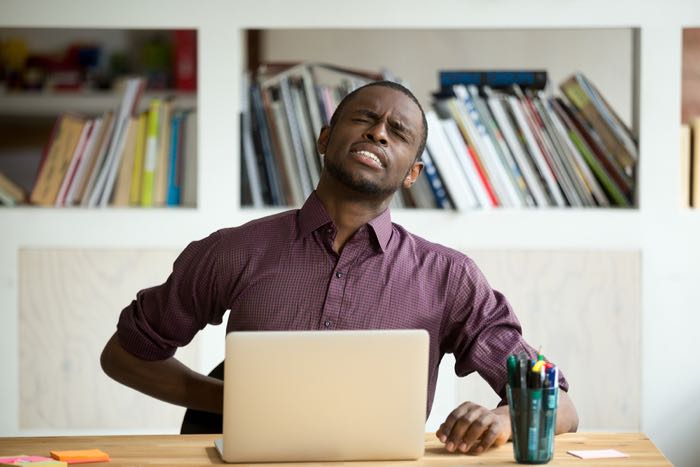by Kate Willett
As a writer, you might spend a lot of time sitting at your desk.
Whether you’re furiously typing the first draft of your novel or staring blankly at a notebook waiting for inspiration to strike, the slightly hunched-over sitting position you likely find yourself in may take its toll on your back, neck, or entire body.
Many writers balance day jobs in which they sit at a desk all day long, with writing at home after work hours, compounding potential back pain.
Research suggests that the Alexander Technique may be able to help.
What is the Alexander Technique?
The Alexander Technique is an educational technique designed to increase movement awareness.
According to the American Society for the Alexander Technique: “By teaching how to change faulty postural habits, it enables improved mobility, posture, performance and alertness along with relief of chronic stiffness, tension and stress.”
Performers of all kinds—athletes, singers, musicians, and actors regularly study the technique to improve breathing, movement and posture. Many others use it to relieve pain by reducing unnecessary physical tension.
Can the Alexander Technique Help Relieve Writing-Related Pain?
A study from the University of South Hampton showed the Alexander Technique was effective in reducing chronic back pain, especially in subjects that had six or more lessons. Benefits increased for those who had 24 lessons.
Study author Paul Little noted, “The people who had 24 lessons had gone down from about 21 days of pain that the usual care group reported to about 3 days in pain.”
In another study published in the European Journal of Integrative Medicine, researchers concluded: “Alexander Technique lessons led to long-term improvements in the way participants lived their daily lives and managed their neck pain. Alexander lessons promote self-efficacy and self-care, with consequent reductions in chronic neck pain.”
In a third study published in the International Journal of Clinical Practice, scientists stated, “Strong evidence exists for the effectiveness of Alexander Technique lessons for chronic back pain and moderate evidence in Parkinson’s‐associated disability.”

How Do I Learn the Alexander Technique?
The Alexander Technique is typically taught in a series of one-on-one lessons. Teachers introduce concepts that help you gain additional awareness of your nervous system, muscular system, and skeletal system.
As private sessions may present an economic impediment for some (especially emerging writers and artists), some teachers offer small group sessions at reduced rates.
Typically, a teacher will instruct you through verbal guidance as well as placing their hands on your neck, back, and head. You’ll remain fully clothed through the session.
Normal street attire can be worn to a session—you’ll be working through typical movements rather than vigorously exercising or stretching. Any touch is typically very light and shouldn’t cause any pain—touching is generally used to bring awareness rather than make any major adjustments.
During lessons, you’ll learn how to approach your typical activities with greater ease, including writing or typing at your desk. While a massage releases tension on a one-time basis, the Alexander Technique focuses on educating a student about his or her own movement to bring greater self-awareness.
According to the National Health Service of the U.K., the main principles of the Alexander technique are:
- How you move, sit and stand affects how well you function.
- The relationship of the head, neck and spine is fundamental to your ability to function optimally.
- Becoming more mindful of the way you go about your daily activities is necessary to make changes and gain benefit.
- The mind and body work together intimately as one, each constantly influencing the other.

Can the Alexander Technique Increase Creativity and Focus for Writers?
Although the evidence is anecdotal, many Alexander Technique teachers believe that the technique can increase creativity.
According to Alexander teacher Joan Arnold, “We all have unconscious movement habits. Without realizing it, we put undue pressure on ourselves. We use more force than we need to lift a coffee pot or a weight bar. We slouch as we sit, unaware that our way of doing things gives our bodies a certain look. We blame body problems on activities — carpal tunnel syndrome on computer work, tennis elbow on tennis. But often it is how we do something that creates the problem, not the activity itself.”
This may prove to be good news for writers. Many may find that back or neck pain while sitting is a distraction or can even cut their work time short. It’s possible the Alexander Technique could be a tool that allows writers to work for longer periods of time with greater concentration.
How Do I Get Started with the Alexander Technique?
If you’re curious about the Alexander Technique and not yet ready to commit to a private session, you can try aspects of the technique on your own.
One principle of Alexander Technique is “constructive rest.” Lie down on a floor (with a yoga mat, carpet, or rug). You’ll want more support than a bed can provide. Putting your knees up may relieve pressure on your lower back, but you can keep them down if that’s more comfortable for you.
Place a book or two under your head so your head aligns with your spine. You don’t want to raise your head as you might with a pillow, but rather create a position that allows your neck to release tension.
Allow yourself to relax into the surface you’re lying on. Notice where you’re holding tension in your body, and see if you can allow those parts of your body to slowly release and sink into the floor. Don’t “do” anything to make this happen (such as clenching and releasing your muscles). You’ll want to simply allow yourself to relax, rather than creating additional tension through scrunching up.
It may help to imagine yourself in a relaxing location. Think to yourself “I’m allowing my neck to be free so that my whole head can release back and up, so my whole spine can lengthen and widen.”
Lying on the floor and thinking may not seem like it can make much of a difference, but practiced a couple times a day, for a few minutes each, you may notice a difference in your posture and relaxation.
Later, when back at your desk, try the thoughts again, starting with “I’m allowing my neck to be free.” While no substitute for a private session, regular practice has the potential to make a substantial difference in your wellbeing as a writer.
For additional reading, Missy Vineyard’s book, How You Stand, How You Move, How You Live: Learning the Alexander Technique to Explore Your Mind-Body Connection and Achieve Self-Mastery. It’s a favorite of Alexander Technique teachers.
Have you tried the Alexander Technique for relieving writing-related pain?
* * *
Kate Willett is a freelance writer located in Los Angeles, CA. She writes about health, politics, and comedy. She is a graduate of the University of California, Berkeley.
Sources
American Society for the Alexander Technique. (n.d.). AMSAT | How is the Alexander Technique Taught. Retrieved from https://www.amsatonline.org/aws/AMSAT/pt/sp/teach
American Society for the Alexander Technique. (n.d.). AMSAT | What is the Alexander Technique. Retrieved from https://www.amsatonline.org/aws/AMSAT/pt/sp/what_is
Hollinghurst, S., Sharp, D., Ballard, K., Barnett, J., Beattie, A., Evans, M., … Little, P. (2008). Randomised controlled trial of Alexander technique lessons, exercise, and massage (ATEAM) for chronic and recurrent back pain: economic evaluation. BMJ, 337(dec11 2), a2656-a2656. doi:10.1136/bmj.a2656
Matthews, A. (n.d.). Alexander Technique: Constructive Rest. Retrieved from https://www.alexandertechnique.com/constructiverest/constructiverest.pdf
NHS. (2017, October 17). Alexander technique. Retrieved from https://www.nhs.uk/conditions/alexander-technique/
NHS. (n.d.). Performance & The Arts – Alexander Technique International. Retrieved from http://alexandertechniqueinternational.com/what-is-the-alexander-technique/why-use-at/performance-the-arts/
Varney, S. (2011, March 28). Alexander Technique: A Balm For Back Pain? Retrieved from https://www.npr.org/2011/03/28/134861319/alexander-technique-a-balm-for-back-pain
Woodman, J., Ballard, K., Hewitt, C., & MacPherson, H. (2018). Self-efficacy and self-care-related outcomes following Alexander Technique lessons for people with chronic neck pain in the ATLAS randomised, controlled trial. European Journal of Integrative Medicine, 17, 64-71. doi:10.1016/j.eujim.2017.11.006
Woodman, J. P., & Moore, N. R. (2011). Evidence for the effectiveness of Alexander Technique lessons in medical and health-related conditions: a systematic review. International Journal of Clinical Practice, 66(1), 98-112. doi:10.1111/j.1742-1241.2011.02817.x

